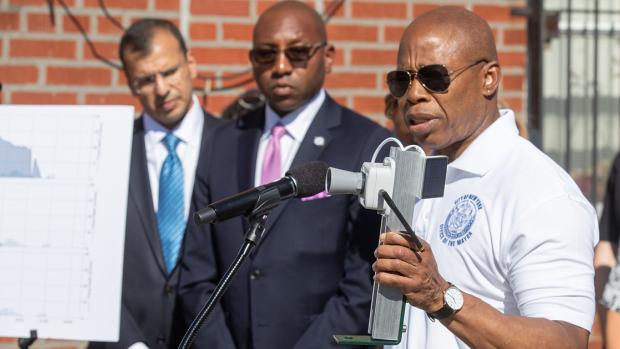New data dashboard reporting street-level flooding in NYC gives government, responders, the public, and researchers real-time information on rising waters
The application is linked to a growing network of flood sensors that provide user-friendly data via an interactive map to alert users to rising waters in flood-prone areas.

New York City Mayor Eric Adams demonstrates a FloodNet sensor at a press conference on Thursday, September 1, 2022. The new FloodNet dashboard will use data from a growing network of these ultrasonic sensors distributed through the city's boroughs in flood-prone areas.
BROOKLYN, New York, Thursday, September 1, 2022 — New York City is girding itself for storm season, which, in the face of accelerating climate change, could mean more frequent and extreme storms like Hurricanes Henri and Ida, and local cloudbursts producing prodigious volumes of stormwater.
The city has a new arrow in its quiver to confront these threats with greater resilience: An academic, government and community consortium called FloodNet, which includes the NYU Tandon School of Engineering, the Science and Resilience Institute at Jamaica Bay (SRIJB) led by CUNY-Brooklyn College, the CUNY Advanced Science Research Center (ASRC), and the NYC Mayor’s Office of Climate & Environmental Justice, and the NYC Office of Technology & Innovation. Developed by a team of researchers including Andrea Silverman, Charlie Mydlarz, Tega Brain, and Elizabeth Hénaff of NYU Tandon; Brett Branco, Executive Director of the SRIJB at Brooklyn College; and Ricardo Toledo-Crow of CUNY ASRC, it features a just-launched, free-to-use, publicly available web tool that will make it easy for communities and government agencies to know where, when and how quickly flood waters are rising, either from overburdened stormwater drains, or coastal seawater surges.
Created in partnership with FieldKit, with funding from the New York State Empire State Development Corporation, the new mobile-ready web dashboard presents real-time data collected by the expanding FloodNet system of low-cost, open-source sensors in flood-prone areas across the city. Currently, FloodNet comprises 30 ultrasonic devices deployed in Brooklyn, the Bronx, Manhattan, Queens, and Staten Island, from which readings are delivered to an interactive map and data visualization platform, allowing users to see the occurrence and depth of flood water at each sensor location.
At a climate resiliency press conference on September 1, 2022, the anniversary of Hurricane Ida Mayor Eric Adams highlighted the expanding FloodNet project, which includes the new dashboard and 500 new sensors.
“I’m a big believer in technology to run our city smarter,” he said, adding that the sensors and dashboard, “Will provide the city with critical infrastructure in order to advice evacuations, travel bans, or road closures.
“This is more than infrastructure; it’s how we are going to protect our city and people from rising sea levels and stronger storms,” he said. “This is how we are going to lead. Everyone takes notice of what happens here in New York and what happens here cascades to the rest of the country.”
“Hurricane Ida’s deadly deluge demonstrated New Yorkers’ vital need for immediate access to real-time flooding information,” said New York City Chief Technology Officer Matthew C. Fraser, in a statement. “When future storms threaten our city, New York City FloodNet will save lives by informing the safety-related decisions made by city agencies, emergency responders, and residents. My office is proud to have partnered with numerous city government agencies and universities on this innovative tech project that exemplifies Mayor Adams’ mission to ‘Get Stuff Done’ for New Yorkers.”
“This is the first time that quantitative data on urban flood occurrence, depth and duration have been measured and provided to the public — we’re excited to share the dashboard with communities, city agency partners, and other researchers,” said Silverman, an Assistant Professor of Environmental Engineering. “We’ve heard many stories and desired use cases for the data from a variety of stakeholders, and are looking forward to seeing how these communities end up using the real-time and historic flood data.”
Said Brett Branco from the Earth and Environmental Sciences Department at Brooklyn College and Executive Director of the Science and Resilience Institute at Jamaica Bay, “We’ve been working with both communities and government for years to better understand the impact that flooding has on the lives of NYC residents. From the frequent nuisance flooding due to high tides around Jamaica Bay, to the catastrophic flooding across all five boroughs that occurs during coastal storms and extreme rainfall events, FloodNet and the data dashboard will help NYC find equitable solutions to these problems.”
The FloodNet project was developed as a collaboration between researchers at NYU Tandon’s Center for Urban Science and Progress (CUSP), the Advanced Science Research Center at the CUNY Graduate Center (CUNY ASRC), and the Science and Resilience Institute at Jamaica Bay (SRIJB) at Brooklyn College, in partnership with the NYC Mayor’s Office of Climate & Environmental Justice and the NYC Office of Technology & Innovation, and with the financial support of the C2SMART Tier 1 U.S. Department of Transportation University Transportation Center at NYU Tandon, the NYU Marron Institute, and the CUNY Office of Research.
The dashboard:
- Displays a rich data set collected by the FloodNet sensors, including the depth and profile of street-level floods over time, which can be of use to community members, city agencies, researchers, emergency response, journalists, and others.
- Provides flood data in real-time as they are collected, and can alert users to floods as they develop.
- Includes an searchable map view that allows users to see at a glance which sensors are currently recording floods.
- Historic data are also available, allowing users to explore and understand the frequency and severity of flooding in locations where FloodNet sensors are deployed, in addition to visualizing floods that occurred during specific events. For example, during Tropical Storm Henri, FloodNet sensors deployed in the Gowanus neighborhood in Brooklyn recorded two distinct flood events on the same night separated by an hour where the water receded. During Ida, sensors recorded three feet of flooding at the intersection of Carroll Street and 4th Avenue in Brooklyn, with flood waters rising quickly, peaking within 20 minutes, creating extremely hazardous conditions.
- Regular flooding related to high tide events can also be visualized, through data collected by flood sensors deployed in coastal neighborhoods.
“An exciting aspect of the Floodnet project is that we’re also using it to train the next generation of young environmental scientist and community-based stewards through the involvement of New York City-based high school, community college and undergraduate students who help us assemble, install and maintain the sensors,” said Toledo-Crow, Director of the ASRC Next Generation Environmental Sensors Lab, who helped design the sensors.
About the Advanced Science Research Center at the CUNY Graduate Center
The Advanced Science Research Center at the CUNY Graduate Center (CUNY ASRC) is a world-leading center of scientific excellence that elevates STEM inquiry and education at CUNY and beyond. The CUNY ASRC’s research initiatives span five distinctive, but broadly interconnected disciplines: nanoscience, photonics, neuroscience, structural biology, and environmental sciences. The center promotes a collaborative, interdisciplinary research culture where renowned and emerging scientists advance their discoveries using state-of-the-art equipment and cutting-edge core facilities.
About Brooklyn College
Widely known for its offer of an excellent education at an affordable tuition and recognized nationally for its diverse student body, Brooklyn College has been an anchor institution within the Borough of Brooklyn and greater New York City for more than 90 years. With approximately 16,000 students in more than 100 undergraduate and graduate degree programs in the arts, humanities, sciences, education, and business, the college is renowned for its rigorous academics, award-winning faculty, distinguished alumni, and community impact. Part of the City University of New York (CUNY), Brooklyn College offers a vibrant and supportive student experience on a beautifully landscaped 35-acre campus in the borough’s Midwood neighborhood.
About the New York University Tandon School of Engineering
The NYU Tandon School of Engineering dates to 1854, the founding date for both the New York University School of Civil Engineering and Architecture and the Brooklyn Collegiate and Polytechnic Institute. A January 2014 merger created a comprehensive school of education and research in engineering and applied sciences as part of a global university, with close connections to engineering programs at NYU Abu Dhabi and NYU Shanghai. NYU Tandon is rooted in a vibrant tradition of entrepreneurship, intellectual curiosity, and innovative solutions to humanity’s most pressing global challenges. Research at Tandon focuses on vital intersections between communications/IT, cybersecurity, and data science/AI/robotics systems and tools and critical areas of society that they influence, including emerging media, health, sustainability, and urban living. We believe diversity is integral to excellence, and are creating a vibrant, inclusive, and equitable environment for all of our students, faculty and staff. For more information, visit engineering.nyu.edu.
Press contacts:
Karl Greenberg
Public Affairs
NYU Tandon School of Engineering
Karl.greenberg@nyu.edu
M: 646.519.1996
Shawn Rhea, M.S.J.
Manager, Media Relations
The Graduate Center, CUNY
srhea@gc.cuny.edu
(212) 817-7180 (o)
(212) 413-3319 (o)
(504) 905-9888 (m)
Rich Pietras
Media Relations Manager
Brooklyn College, The City University of New York
Richard.Pietras@brooklyn.cuny.edu
Brooklyn, NY 11210
718-951-5000 (ext. 6350)
###









